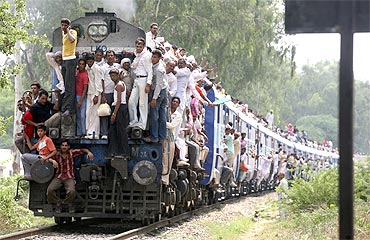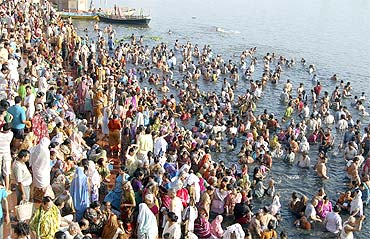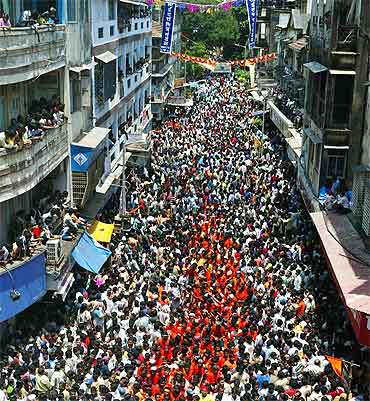 | « Back to article | Print this article |
India's population 1.21 billion
India's population rose to 1.21 billion people over the last 10 years -- an increase of 181 million, according to the new census released on Thursday. Significantly, the population growth is slower for the first time in nine decades.
India, which accounts for world's 17.5 per cent population, comprises 623.7 million males and 586.5 million females, said a provisional 2011 Census report.
China is the most populous nation, accounting for 19.4 per cent of the global population.
The country's headcount is almost equal to the combined population of the United States, Indonesia, Brazil, Pakistan, Bangladesh and Japan put together, it said.
The population has increased by more than 181 million during the decade between 2001 and 2011, the report said. The growth rate in 2011 is 17.64 per cent in comparison to 21.15 per cent in 2001.
The 2001-2011 period is the first decade -- with the exception of 1911-1921 -- which has actually added lesser population compared to the previous decade, Registrar General of India and Census Commissioner of India C Chandramauli said in presence of Home Secretary Gopal K Pillai.
Among the states and union territories, Uttar Pradesh is the most populous state with 199 million people and Lakshadweep the least populated with 64,429 people.
The combined population of UP and Maharashtra is bigger than that of the US.
India's population = US+Indonesia+Brazil+Pakistan+Bangladesh
The highest population density is in Delhi's north-east district (37,346 per sq km) while the lowest is in Dibang Valley in Arunachal Pradesh (just one per sq km).
The Census indicated a continuing preference for male children over female children. The latest child sex ratio is 914 female against 1,000 male -- the lowest since Independence.
"This is a matter of grave concern," Chandramauli said.
According to the data, literates constitute 74 per cent of the total population aged seven and above and illiterates form 26 per cent.
The literacy rate has gone up from 64.83 per cent in 2001 to 74.04 per cent in 2011, showing an increase of 9.21 per cent.
Interestingly, the addition of 181 million during 2001-2011 is slightly lower than the total population of Brazil, the fifth most populous country in the world. While China has 19.4 per cent of the world's total population, India has 17.5 per cent of the world population.
However, the percentage decadal growth during 2001-2011 has registered the sharpest decline since independence -- a decrease of 3.90 percentage points from 21.54 to 17.64 per cent.
Apart from UP, other most populous states are -- Maharashtra (112.3 million), Bihar (103.8 million), West Bengal (91.3 million) and Andhra Pradesh (84.6 million).
'Significant fall in the growth rate of population'
The least populous states and union territories are -- Daman and Diu (2,42,911), Dadra and Nagar Haveli (3,42,853), Andaman and Nicobar Islands (7,79,944) and Sikkim (6,07,688).
The percentage decadal growth rates of the six most populous states have declined during 2001-2011 compared to 1991-2001: Uttar Pradesh (25.85 per cent to 20.09 per cent), Maharashtra (22.73 per cent to 15.99 per cent), Bihar (28.62 per cent to 25.07 per cent), West Bengal (17.77 per cent to 13.93 per cent), Andhra Pradesh (14.59 per cent to 11.10 per cent and Madhya Pradesh (24.26 per cent to 20.23 per cent).
"For the first time, there is a significant fall in the growth rate of population in the Empowered Action Group states after decades of stagnation," Chandramouli said.
The EAG states are: UP, Bihar, Rajasthan, Uttarakhand, Jharkhand, Madhya Pradesh Chhattisgarh and Orissa.
The total number of children in the age group of 0-6 is 158.8 million --- five million less since 2001.
Twenty states and UTs now have over one million children in the age group of 0-6 years.
On the other extreme, there are five states and UTs that are yet to reach the 100,000 mark.
Uttar Pradesh (29.7 million), Bihar (18.6 million), Maharashtra (12.8 million), Madhya Pradesh (10.5 million) and Rajasthan (10.5 million) constitute 52 per cent children in the age group of 0-6 years.
Lowest sex ratio in Haryana
The child sex ratio (0-6 years) in Haryana and Punjab is lowest among all states. Haryana has 830 female children and Punjab 846 against per 1000 male child.
The highest child sex ratio is in Mizoram (971 females against 1000 males) and Meghalaya (970).
Haryana's Jhajjar (774 females) and Mahendragarh (778 females) districts have the lowest sex ratio while Lahul and Spiti district of Himachal Pradesh have the highest sex ratio (1,013 female).
However, the overall sex ratio at the national level has increased by 7 points since the 2001 Census to reach 940 females per 1000 male at Census 2011.
This is the highest sex ratio recorded since 1971 and a shade lower than 1961. Increase in sex ratio is recorded in 29 states and UTs while three major states -- Bihar, Gujarat and Jammu and Kashmir -- have shown a decline in sex ratio as compared to census 2001.
Between 2001 and 2011, literacy rate of males is 82.14 per cent and females is 65.46 per cent. In 2001, the male literacy rate was 75.26 per cent and female 53.67 per cent.
Ten states and UTs viz. Kerala, Lakshadweep, Mizoram, Tripura, Goa, Daman and Diu, Puducherry, Chandigarh, NCT of Delhi and Andaman and Nicobar Islands have achieved literacy rate of above 85 per cent, the target set by the Planning Commission to be achieved by 2011-12.
Mizoram has highest literacy rates
The gap of 21.59 percentage points recorded between male and female literacy rates in 2001 census has reduced to 16.68 percentage points in 2011. The Planning Commission has set up a target of reducing this gap to 10 percentage points by 2011-12.
Among the states and UTs, literacy rate in Kerala is highest -- 93.91 per cent, followed by Lakshadweep (92.28 per cent) while lowest is in Bihar (63.82 per cent) followed by Arunachal Pradesh (66.95 per cent).
Mizoram's two districts -- Serchhip (98.76 per cent) and Aizawl (98.50 per cent) have recorded highest literacy rates while Madhya Pradesh's Alirajpur district (37.22 per cent) and Chhattisgarh's Bijapur district (41.58 per cent) recorded lowest literacy rates.
The density of population in 2011 is 382 persons in per sq km in comparison to 325 in 2001. National capital Delhi (11,297) has the highest density of population followed by Union Territory Chandigarh (9,252) in per sq km while Arunachal Pradesh (17) and Andaman and Nicobar Islands (46) have the lowest density of population.
27 lakh enumerators involved
Chandramouli said post enumeration summary will be started soon and the final data is expected to be available next year and any error can be detected only then.
There was a 2 per cent error in the 2001 Census report.
The provisional population report is arrived at by adding the population as reported by each enumerator for enumeration block assigned to him/her.
"There could be errors in addition or there could be cases of omission/ duplication of enumerator blocks in the provisional report. The final population will be arrived at by scanning of schedules, data processing and other checks," Chandramouli said.
The Census 2011 is the 15th census of India since 1872 and conducted in two phases -- house-listing and housing census (April to September 2010) and population enumeration (February 9 to 28, 2011).
The Census covered all 35 states and UTs and cost Rs 2,200 crore. As many as 27 lakh enumerators were involved in the exercise where 8,000 metric tonnes of paper and 10,500 metric tonnes of material moved.





